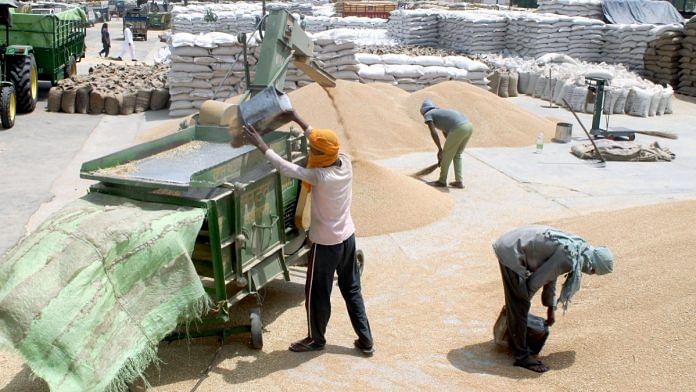New Delhi: Despite the unabated rise in food prices, which drove retail inflation to a five-month high of 7.41 per cent in September, there is limited legroom for the government to intervene in the market by selling public stocks to cool prices.
Data from the Food Corporation of India (FCI) shows that the government’s wheat stocks stood at 22.7 million tonnes at the start of this month, which is less than half of where they stood in October 2021 (46.8 million tonnes).
Wheat stocks — at their lowest in six years — are just above the operational and strategic buffer norm of 20.5 million tonnes in October.
Another cause for concern is the Rabi crop of winter wheat which is yet to be planted and will hit the markets only in April 2023. Retail wheat flour prices have already risen 18 per cent year-on-year (as on 13 October).
In May, India banned wheat exports after a heatwave blighted the crop the previous month.
Also Read: Why India banned export of broken rice & could more curbs be in the offing
Where rice stocks stand
Compared to wheat, rice stocks are at comfortable levels but the future price outlook will depend on the actual crop size as farmers begin to harvest their Kharif crop starting this month.
Public stocks of rice, as of October, stood at 20.5 million tonnes — close to double the stocking norm of 10.5 million tonnes. Additionally, FCI is also sitting on close to 12 million tonnes of unmilled paddy (October 2022).
In contrast to retail wheat flour prices, the year-on-year rise in retail rice prices was a modest 7.3 per cent as of 13 October.
However, excess rains in September damaged early sown basmati rice in parts of Haryana and Punjab after delayed and deficit rains severely impacted plantings in several states.
For now, the Agriculture Ministry estimates Kharif rice production to fall by about 7 million tonnes in 2022-23 compared to the previous year.
Food inflation on the rise
Food inflation continues to be stubbornly high despite several attempts by the government to rein it in. Inflation numbers released earlier this week show consumer food prices rose by 8.6 per cent year-on-year in September, marking the highest monthly increase since November 2020.
A reading of inflation numbers shows that the surge in prices of two food categories contributed most to the spike — vegetables (18 per cent) and cereals (11.5 per cent).
The unabated increase in food prices was despite India’s decision to impose export curbs on wheat and rice and to lower import duties on edible oils.
Beyond rice and wheat, several categories of vegetables have seen a sharp rise in prices.
Data from the Ministry of Consumer Affairs shows that current retail prices of potatoes and tomatoes are 28 per cent and 13 per cent higher, respectively, year-on-year. Prices of perishables could spike further as continuous unseasonal rains in October damaged vegetable crops, alongside cereals and pulses.
Apart from staples, milk prices have also been on the rise (7 per cent year-on-year in September 2022) driven by a spike in price of fodder and lower milk output due to the lumpy skin disease outbreak.
“Food prices, especially of cereals, milk and vegetables are the main culprits… and the fresh arrival of Kharif output would provide some comfort on that front. RBI would be concerned about high food inflation and its adverse impact on inflationary expectations,” ratings company Care Rating said in a note after the release of inflation numbers on 12 October.
Meanwhile, annual inflation rate based on wholesale food prices eased to 8.08 per cent Friday for the month of September, registering a drop from 9.93 per cent in August.
(Edited by Amrtansh Arora)
Also Read: Food ministry says deficit rains may hit rice production, banks on export curbs to tame prices



